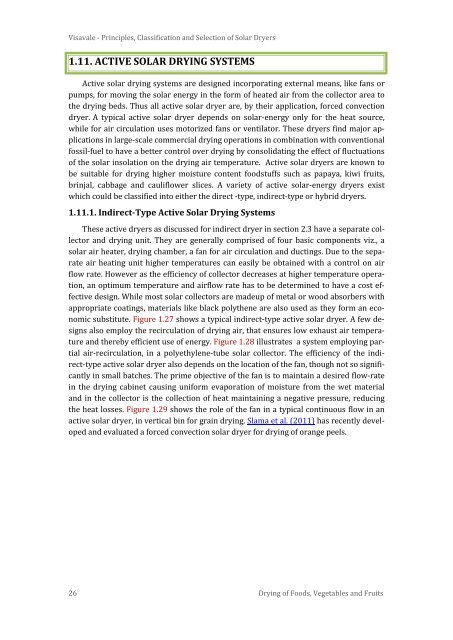Solar Drying: Fundamentals,Applications and Innovations - National ...
Solar Drying: Fundamentals,Applications and Innovations - National ...
Solar Drying: Fundamentals,Applications and Innovations - National ...
You also want an ePaper? Increase the reach of your titles
YUMPU automatically turns print PDFs into web optimized ePapers that Google loves.
Visavale - Principles, Classification <strong>and</strong> Selection of <strong>Solar</strong> Dryers<br />
1.11. ACTIVE SOLAR DRYING SYSTEMS<br />
Active solar drying systems are designed incorporating external means, like fans or<br />
pumps, for moving the solar energy in the form of heated air from the collector area to<br />
the drying beds. Thus all active solar dryer are, by their application, forced convection<br />
dryer. A typical active solar dryer depends on solar-energy only for the heat source,<br />
while for air circulation uses motorized fans or ventilator. These dryers find major applications<br />
in large-scale commercial drying operations in combination with conventional<br />
fossil-fuel to have a better control over drying by consolidating the effect of fluctuations<br />
of the solar insolation on the drying air temperature. Active solar dryers are known to<br />
be suitable for drying higher moisture content foodstuffs such as papaya, kiwi fruits,<br />
brinjal, cabbage <strong>and</strong> cauliflower slices. A variety of active solar-energy dryers exist<br />
which could be classified into either the direct -type, indirect-type or hybrid dryers.<br />
1.11.1. Indirect-Type Active <strong>Solar</strong> <strong>Drying</strong> Systems<br />
These active dryers as discussed for indirect dryer in section 2.3 have a separate collector<br />
<strong>and</strong> drying unit. They are generally comprised of four basic components viz., a<br />
solar air heater, drying chamber, a fan for air circulation <strong>and</strong> ductings. Due to the separate<br />
air heating unit higher temperatures can easily be obtained with a control on air<br />
flow rate. However as the efficiency of collector decreases at higher temperature operation,<br />
an optimum temperature <strong>and</strong> airflow rate has to be determined to have a cost effective<br />
design. While most solar collectors are madeup of metal or wood absorbers with<br />
appropriate coatings, materials like black polythene are also used as they form an economic<br />
substitute. Figure 1.27 shows a typical indirect-type active solar dryer. A few designs<br />
also employ the recirculation of drying air, that ensures low exhaust air temperature<br />
<strong>and</strong> thereby efficient use of energy. Figure 1.28 illustrates a system employing partial<br />
air-recirculation, in a polyethylene-tube solar collector. The efficiency of the indirect-type<br />
active solar dryer also depends on the location of the fan, though not so significantly<br />
in small batches. The prime objective of the fan is to maintain a desired flow-rate<br />
in the drying cabinet causing uniform evaporation of moisture from the wet material<br />
<strong>and</strong> in the collector is the collection of heat maintaining a negative pressure, reducing<br />
the heat losses. Figure 1.29 shows the role of the fan in a typical continuous flow in an<br />
active solar dryer, in vertical bin for grain drying. Slama et al. (2011) has recently developed<br />
<strong>and</strong> evaluated a forced convection solar dryer for drying of orange peels.<br />
26 <strong>Drying</strong> of Foods, Vegetables <strong>and</strong> Fruits

















